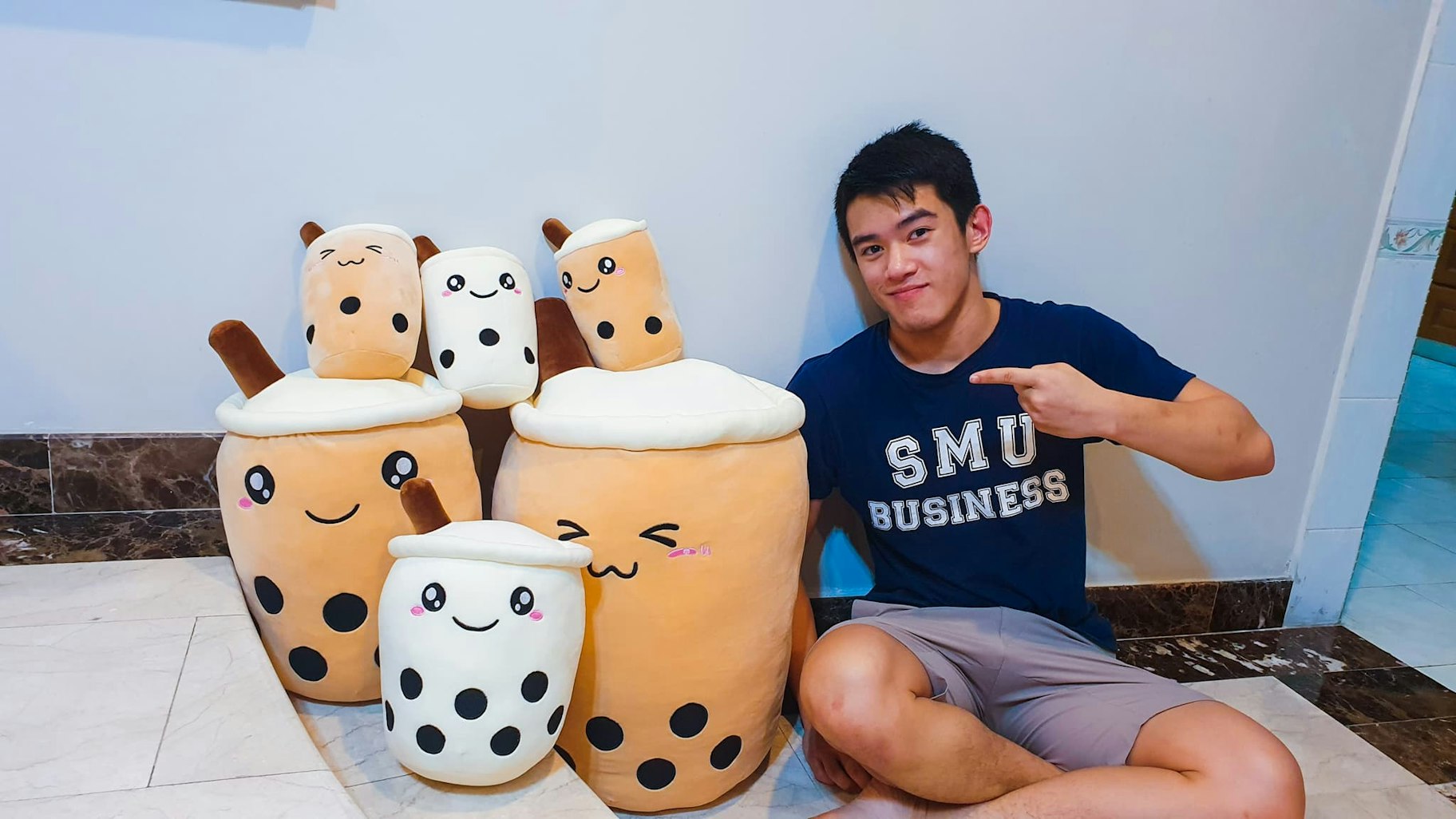After just a few email exchanges with Tze Hing Chan, it was abundantly clear the young Malaysian entrepreneur is the definition of a go-getter.
Driven to succeed, Tze even transferred out of his college exchange in Melbourne to move to Singapore because he found the Australian university atmosphere too laid back.
After completing his studies in finance and marketing, Tze immediately launched himself an internship with a startup. During this two-month internship, he met ecommerce entrepreneurs and learned about the dropshipping business model.
A year later, Tze would make $19,000 in profit from just two months of dropshipping bubble tea plush toys.
Oh, and did I mention this was all in the middle of a pandemic?
But, naturally, Tze didn’t move straight from learning about dropshipping to making bank. There were a ton of failures and learnings along the way.
Speaking with Tze, we’ve learned how he built up the skills that allowed him to make more cash than most newly graduated students could dream of. We also learned Tze’s winning product, his store’s name, and URL, as well as other insider tips and tricks he used to boost his sales.
A dropshipper is rarely willing to be this open about their product and store, so believe me when I say this stuff is absolute gold. Let’s get into it.
Post Contents



First Forays into Ecommerce
During his internship, Tze met and spoke about ecommerce with many entrepreneurs and eventually learned about dropshipping. He quickly found himself dedicating his weekends to researching how to start an online business.
After some time, Tze was convinced to give it a shot and started with a tried and true dropshipping product: Phone cases. He knew that winning dropshipping products were those that took advantage of a trend, which is why he landed on bubble tea – also called boba – as his niche.
→ Click Here to Launch Your Online Business with Shopify
“I knew that the bubble tea trend was up and coming, especially in Asian communities, so I looked around for bubble tea stuff on AliExpress. I found phone cases, and that was my very first product.”
Tze put together a bubble tea-themed store with the phone cases as the main items. With his store finished, he started running ads and even made a few sales. However, despite the sales, the store still lost around $200 after ad spend. But Tze was far from disappointed.
“I didn’t really earn a profit, but at that point in time, I knew it worked, so [dropshipping] was a proven concept to me.”
From bubble tea phone cases, Tze went on to open a bunch of different stores. At one stage, he sold kitchen appliances like handheld knife sharpeners or vegetable cutters. He even partnered with a former coworker from his internship to open another phone case store.
None of these stores made a profit, but they were slowly teaching Tze the ins and outs of ecommerce. Tze would take everything he learned from his failed stores and apply the lessons to his next venture. He knew that eventually, he would build a successful store.
Sure enough, in late 2019, Tze finally had his first taste of success.
A Plump Novelty Product Gives Fat Returns
After finding a cute seal plush toy, Tze built a store around the item and began running Facebook ads. The toy was a hot product, popular with dropshippers worldwide, and soon enough, he had a flood of purchases.
In just two weeks, Tze made over $7500 in revenue, leaving him with around $1500 profit. But he knew the hype would be short-lived, and he didn’t want to tempt fate. So, after that initial rush, he stopped all ads.
“I was pretty excited, but eventually, the trend died down. It was before Christmas, and I knew that the [products] weren’t going to make it for Christmas, so I just stopped running ads just to make sure I don’t get any angry customers.”
From Profits Back to Losses
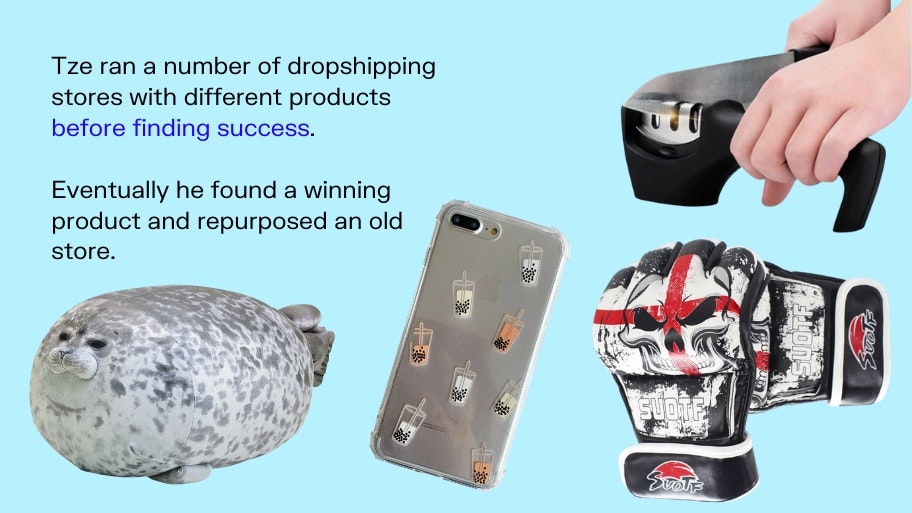
The seal plush toy store was Tze’s first online store that had made a profit, and the success rejuvenated him.
Keen to make more money, he decided to try a niche he was passionate about and built a store around mixed martial arts apparel. Having learned from his other stores, he realized that having a professional and well-organized business was worth investing time in. He imported over 50 products, removed the background on all the images, and logically organized everything.
However, the store was still a total failure. Upon reflection, Tze now understands where he went wrong.
“I guess one thing I found out about dropshipping is that your main customers are mainly impulse buyers. So, for mixed martial arts apparel, at least, if people want to get quality products, they would go to reputable brands instead of taking off of a Facebook ad and just buying off a website they’ve never even heard of. So that was one thing I learned, and I closed that store.”
It was now April 2020, and Tze knew that finding a regular job as a recent graduate during a pandemic would be difficult. He decided to keep on with dropshipping, taking all the learnings from his first eight stores and applying them to his next attempt.
This time, rather than starting a new store, Tze went back to the only store that had turned a profit: the plush toy store. He began importing as many soft toys as possible. And then he caught a lucky break.
Right Time, Right Page, Right Niche
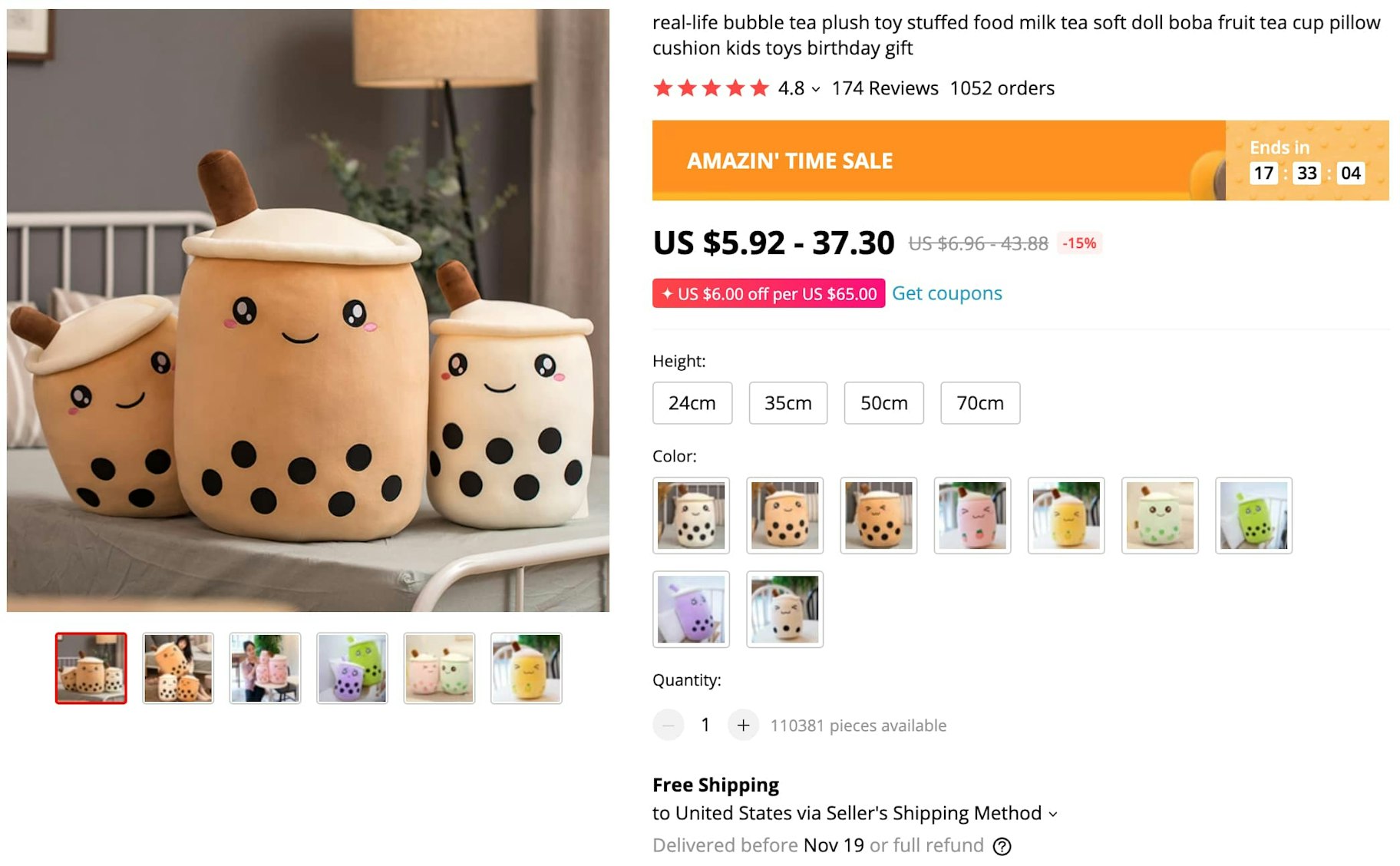
Back when Tze had started his very first store, he’d spent a ton of time searching for bubble tea-related items. Although he knew the beverage was trendy, there still wasn’t a vast range of options available. That’s why, when he chanced across a brand new bubble tea plush toy, he knew he was onto a winner.
“One day, I came across that bubble tea plush. And as soon as I saw it, I knew it was going to work because I was already looking for bubble tea plushes before this. A few days ago, I didn’t really see it, and then, on that day, I saw it, immediately imported it, and just started running ads, and it just took off from there.”
Within a few hours, Tze had ads online, and the customers started rolling in. He specifically targeted Asian-Americans, knowing boba/bubble tea was popular within the Asian community and that America was a big market.
Looking back, he knows he was incredibly fortunate to find a new product that no one else was selling.
“Yeah, just lucky. I was just like at the right time, on the right page.”
Building a Plush Toy Empire
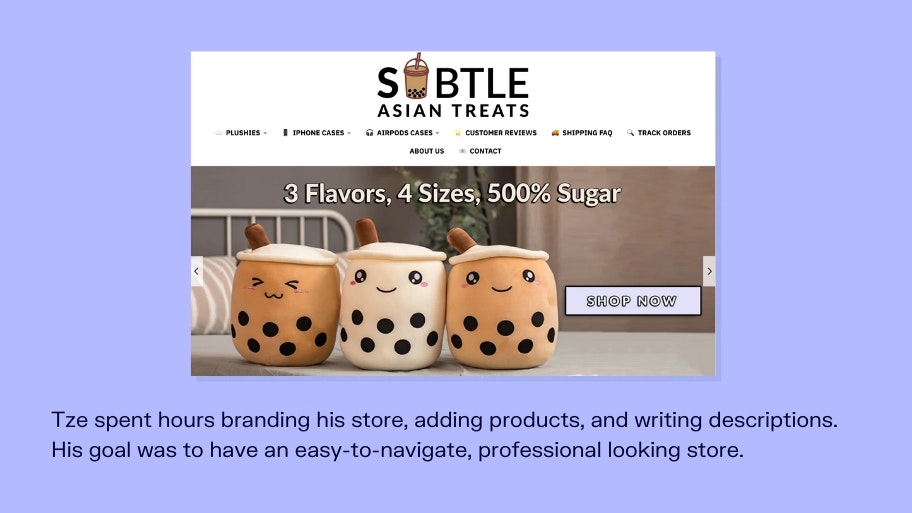
Tze knew his bubble tea plush toys were his winning product, but he also added other items to his store. He grouped all the toys into categories like “land animals,” “aquatic animals,” and “non-animals” so customers could easily find what they were looking for. He removed the images’ backgrounds to look uniform and spent time writing unique descriptions for each product. It wasn’t easy, but he’s glad he did it.
“I spent, I think, two entire weeks daily just in front of my laptop, looking for products, importing them, writing descriptions, removing the backgrounds. Product descriptions were hell. I spent so much time thinking of descriptions for each and every product, but I guess it paid off because it’s personalized for each product.”
Tze’s reasoning for adding so many products – in the end, he had over 100 – was that he wanted his store to look like an authority on plush toys. After all, Tze reasoned, you wouldn’t go to Nike or Adidas and only see one pair of shoes. By having so many different varieties of toys, he increased his chances of attracting customers who like plush toys, even if it did take extra work.
In addition to making each description unique, he also took the time to adopt his audience’s tone and voice, something that took a lot of research.
“I had to speak like how my target market would speak, and that took a lot of brain-bending and stuff because I don’t speak that way. I just had to do a lot of market research and just scrolling through Facebook groups.”
Facebook groups also provided Tze with other inspiration, including his store’s name. Knowing the Facebook page, Subtle Asian Traits was incredibly popular; he made his store a reference to the page and named it Subtle Asian Treats.
Making the Most Out of Each Visitor
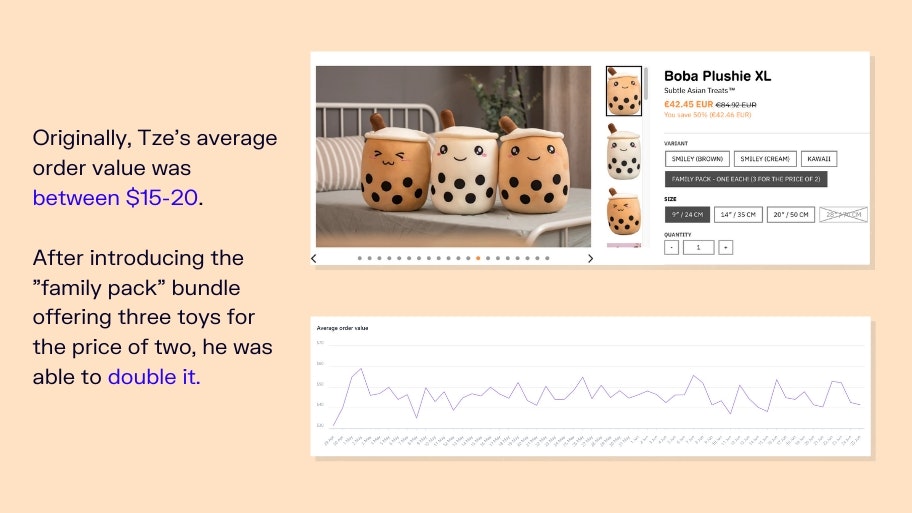
With more than 100 products uploaded to his store, Tze’s visitors certainly had many choices regarding what to buy. However, the majority were entering via ads and opting to buy a single individual bubble tea plush toy.
While it was great to have customers, Tze’s average order value (AOV) was around $15-20, and he wanted to increase it.
Given he had three slightly different looking bubble tea plush toys, he created a bundle where customers got three slightly different toys. Better yet, customers only paid the price of two toys and got the third for free.
It worked immediately.
Not only did customers love it because they thought they’d got a third toy for free, but Tze was also particularly proud because he managed to double his AOV.
Although bundling products like this created extra work for Tze when it came to fulfilling orders, he was more than happy to do it in exchange for a bump in profits.
With his ads working well and the new bundle increasing his profits, Tze was thrilled. However, problems soon developed.
Copycats and Rivals Slow Business
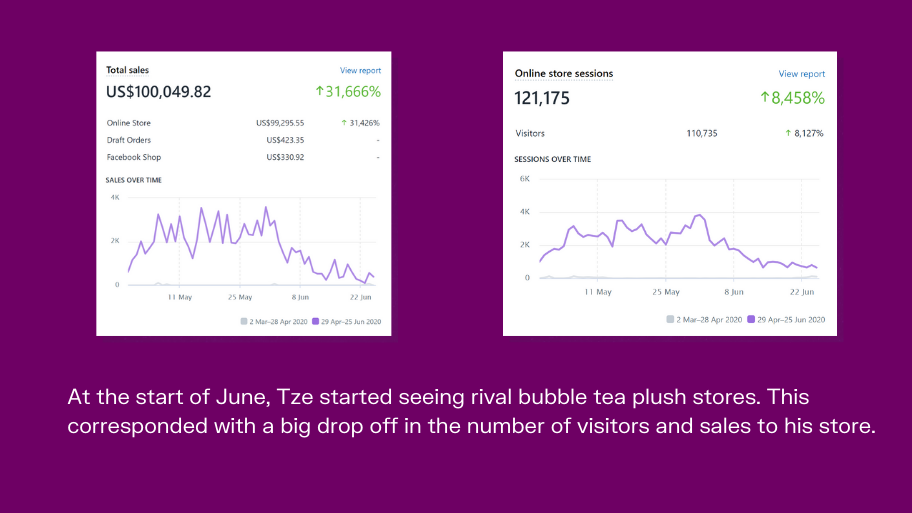
Tze knew he’d had luck finding his winning product just as it was added to AliExpress and was aware that his monopoly on the market would eventually end. Because dropshipping has such a low barrier to entry, there’s very little to stop other entrepreneurs from coming in and selling the same products, and soon enough, copycat bubble tea plush toy stores emerged.
After two months of a monopoly, Tze had competition. Some even stole his product descriptions and ads, knowing it had worked well for him.
Tze’s share of the market dropped massively, and orders slowed to a trickle. The boom was over, but he’d done incredibly well for himself.
Altogether Tze had sold 2579 products spread over 2245 orders. Knowing his audience and the popularity of bubble tea was the key to Tze’s success, and of the 2579 products sold, 2041 were bubble tea toys.
In those two months, Tze had made a massive $100,000 in revenue. Of that, $31,000 was ad spend and $48,000 was spent on goods and shipping. In the end, he had around $19,000 in straight profit. He managed an average of $24.57 profit per transaction.
With competition on the scene, Tze has scaled back his ads, and although he still gets some orders, he’s just breaking even at this stage.
Despite this, Tze is thrilled with his accomplishment. He launched using around $3,000 as his starting budget and managed to generate $19,000. Not only that, but he did it all on his own, with no help from a business partner or virtual assistant. He learned all the ins and outs of ecommerce on the job and has a healthy success to show for it.
Next Steps

Tze never considered his plush toy store a long-term project, so he wasn’t heartbroken when competition stores opened. Instead, he was keen to move onto his next project: Launching a new brand.
Using the profits from his dropshipping store, Tze has partnered with some of his friends to launch an affordable premium activewear brand in Malaysia. It’s an exciting project that’s just getting started.
“It’s just still in the R&D phase. So we are focusing on the Malaysian market because, in the Malaysian market, there’s not really a premium activewear brand in the country. There’s budget activewear brands, but not really affordable premium [brands]. So premium for us is like Nike, Adidas, but they’re pretty expensive, so we looked to go in the middle, offer premium and affordable activewear to the Malaysian market.”
Tze’s hoping the activewear brand will be an exciting new challenge. And given his knowledge of the local Malaysian market, he hopes it’ll be a success. But, even if it’s not, Tze’s not overly concerned.
“I hope it works out. If it doesn’t work out, I’ll just get a job.”
Tze’s Takeaway Tips
After spending two months working full time on his store, Tze has learned a lot and has a few ideas about why his plush toy store was such a success. Here he shares the knowledge that took him months of failed stores and one massive success to accumulate.
1.Knowing an Audience and Then Finding a Product
When talking about his winning product, Tze firmly believes that his store succeeded because he had the perfect match of a great product and knew the ideal target audience.
“One big reason why boba worked was because it appealed to people’s cultures. So there were a lot of other cute products that I tried importing into my store, and I tried marketing, but they just didn’t work. But I felt like boba worked because it appealed to a demographic, specifically, Asian demographics – it’s a trend right now.”
In his experience, a winning product has to be cute and personally appeal to customers in some way, such as culture. In the end, he says, it’s easy to find an item that ticks one box, but it has to tick several others if you truly want to sell a winning product.
2. Store Uniformity
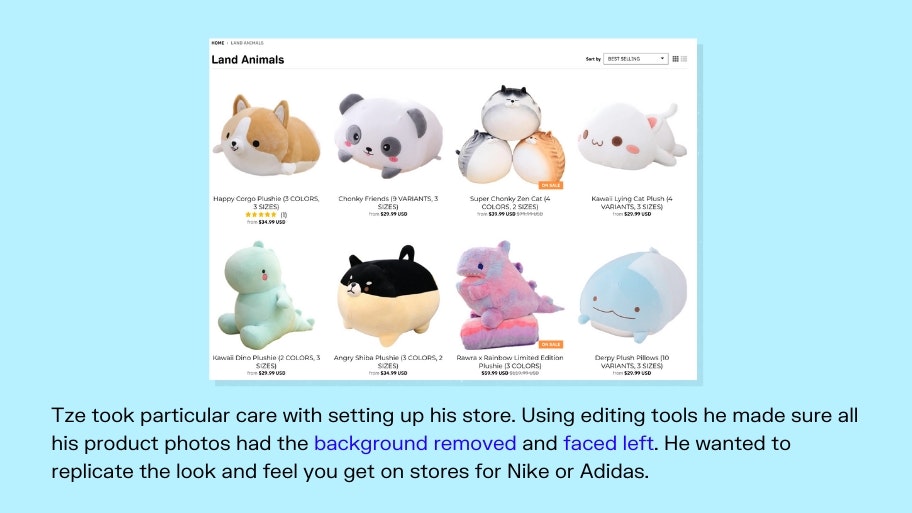
I was shocked that Subtle Asian Treats was a dropshipping store when I saw it for the first time. The layout is professional, logical, and it looks absolutely legitimate. Speaking with Tze, this was one of his primary goals for the store.
Using Photoshop and a background removing tool, Tze was able to edit all his product pictures, so they faced the same direction and had the same appearance. Spending time making the images was time well spent as he could then use the pictures in ads on Facebook.
3. Making the Most of Every Customer
Every customer that clicked on Tze’s ads and landed on his website cost him money, so he wanted to make sure that they spent as much money as possible.
Building the “three for the price of two” bundle was an excellent way to quickly double his AOV with no additional cost, except for a little extra fulfillment time. Tze says it’s a trick that his competitors have failed to copy, and given how much it helped him, he believes they’ve missed a lucrative opportunity.
Aside from including bundles on product pages, you can also cross-sell and upsell. These are all tactics that can skyrocket your store’s AOV, and all it costs is set up time.
4. Customer Satisfaction and Engagement
Tze wanted to be transparent with his customers through the buying process to build as much trust as possible. His product pages included shipping times and even where his products were coming from. In the end, he believes it helped keep refunds and chargebacks to a minimum.
With COVID-19 affecting delivery times, he was sure to have a robust refund and return policy. He also had tactics for dealing with significant delays. For example, customers could get a discount on future purchases or a refund once they received their product in exchange for a fair product review.
Tze also took the time to interact with customers. He was active on the store’s Facebook and Instagram pages, liking and replying to all comments. Through this, he built relationships with influencers and increased brand recognition. He also responded to all customer messages and emails within half a day, so customers never felt like they were dealing with bots or a scam site.



